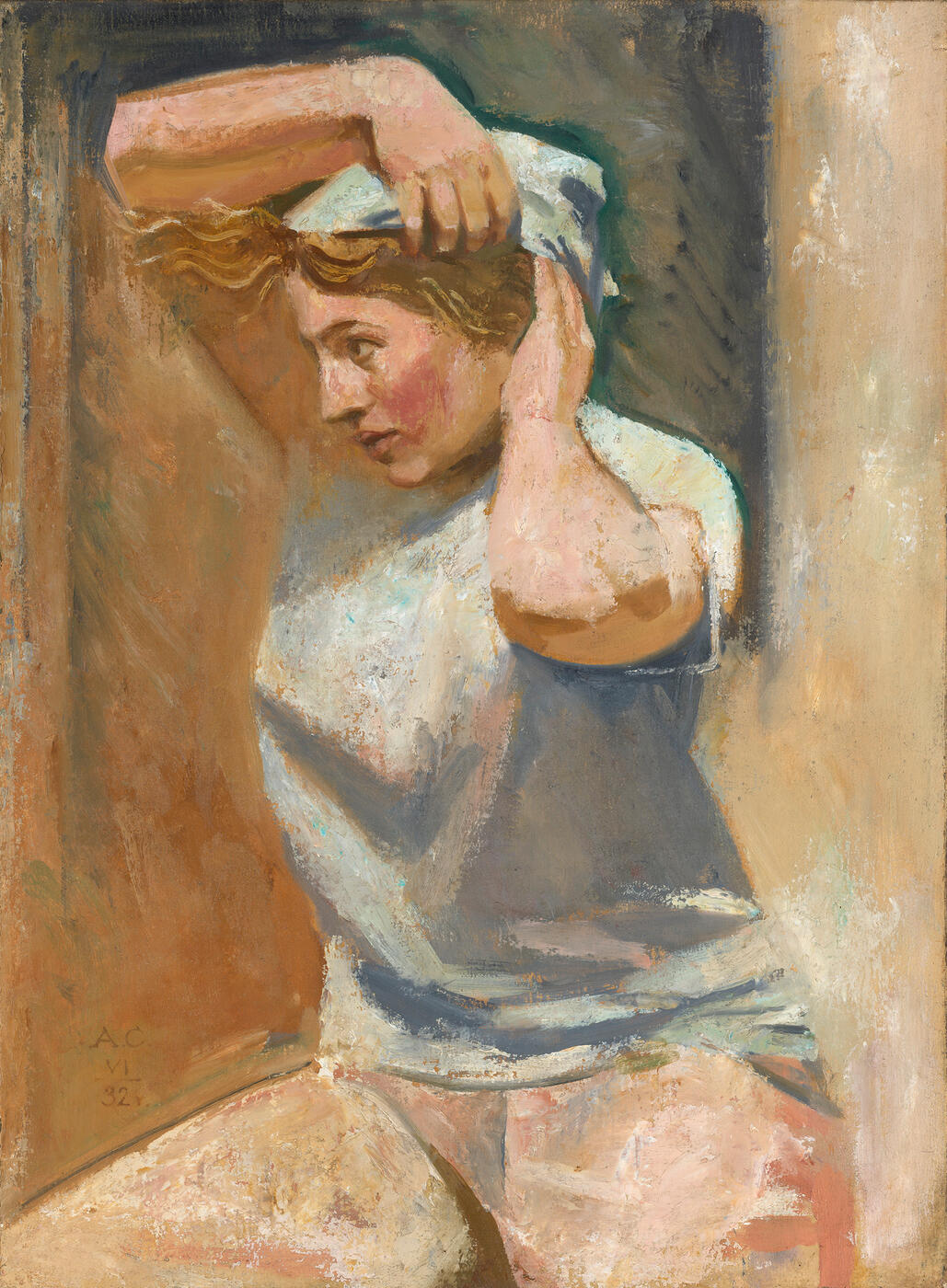MacDougall's Russian Art Auctions 25-27 November 2019
25 November 2019

* 216. SAMOKHVALOV, ALEXANDER (1894–1971)
Metrostroevka, signed with initials and dated.
Oil on canvas, 93.5 by 68 cm.
180,000–250,000 GBP
Provenance: Acquired from Maria Kleschar-Samokhvalova, the artist’s widow, by the art collector Boris Vasiliev, c. 1984 (label on the stretcher).
Collection of Boris Vasiliev, Leningrad (labels on the stretcher, stamps on the reverse and on the label on the stretcher).
Acquired from the above by the previous owner in the 2000s.
Important private collection, USA.
Literature: A. Samokhvalov, Moi tvorcheskii put, Leningrad, Khudozhnik RSFSR, 1989, p. 207, illustrated; p. 316, listed.
Alexander Samokhvalov’s painting Metrostroevka, offered here for auction, is one of the key Soviet images of the second third of the twentieth century. Dated 1932, the work in reality was most likely painted later by the artist. Samokhvalov’s use of his early subject matter could well have taken place in the post-war period. The artist returned with nostalgia to the beginning of the 1930s, when it was precisely the images of the heroines of labour and sport — the determined young girls who were Komsomol members, athletes and workers, actively involved in socialist construction and public life — brought the artist his greatest success and came to be his hallmark.
Art at that time faced the vital task of creating a generalised image-type of Soviet Man, which was one of the main goals of the nascent Socialist Realism. In this context, any portrait amounted to an ideological statement, and Samokhvalov strove purposefully, as he moved on from canvas to canvas, to find this ideal character type for the collective dream.
In 1932, the date the artist put on the work, he was also working on the composition of the famous Girl in a Sports Shirt (The State Russian Museum), which became a Soviet art icon at the time. The “Soviet Gioconda”, as critics immediately dubbed it, proved to be Samokhvalov’s keynote work, expressing his main aspirations during that period, i.e. a formal commitment to some aspects of high classical art — the art of antiquity and the Renaissance — and the simultaneous desire to showcase an up-to-date ideological and artistic concept. The portrait of the young female worker stands on these same foundations too.
In the portrait’s composition, the artist resorts to his favourite technique, successfully tested in Girl in a Sports Shirt. He shows the central figure in close-up, spreading the image over almost the whole surface of the canvas. The subject’s internally dynamic pose forms the basis of his artistic approach. The model does not just pose; she displays a readiness for “labour and defence”. In just a minute’s time, after tucking her windblown hair into a kerchief, she will go off to forge a socialist future at the lathe, arm herself with plastering tools or a pneumatic drill on a communist building site, sit down at the controls of a crane or dash off to boost Soviet livestock farming.
The juxtaposition of the profile depiction of the head, with the arms raised towards it, and the three-quarters turn of the body immediately gives the heroine of labour a vigorous rhythm. The figure of the girl, which stands out in relief with its precise, elastic forms, creates a plastically expressive silhouette that is conveyed by a light, sparing palette of bluish-grey and delicate pink-ochre tones. The aptly contrived colour balance focuses attention on the main point — the worker’s face. Here the artist undoubtedly followed the real-life features, but at the same time, after much analytical and synthesising work, he departed from them by generalising and perfecting every one of the model’s essential features. We can see the glow of health, the perfectly straight nose, the sculptural clump of golden hair, the upright posture, the vigorous, springy movements, the inspired look and the typical clothing of young Soviet workers — the T-shirt that emphasises the physicality of the artist’s young contemporary. Such are the invariable attributes of his always recognisable characters.
In Samokhvalov’s paintings, the female members of the Spartak sports society and the Society for the Promotion of Aviation and Chemical Defence, physical education instructors, female metro construction workers and women delegates become a new type of classical heroine and are presented as social and aesthetic exemplars. The stern and inspirational female workers were captured by the artist in the course of their heroic work, just before it or during a brief, rather comfortless break. “Their detachment from domestic life, their new, different work and different concerns gave them an aura of romance of a completely new and unprecedented kind,” Samokhvalov was to write (A. Samokhvalov, Moi tvorcheskii put, Leningrad, 1977, p. 116).
In the picture of the young worker that inherits the techniques used in the earlier portraits of members of the Lenin’s Cause commune, the artist manages to endow the appearance of his contemporary with a degree of generalisation that enables the typical image of a person rooted in a specific era to be seen in the portrait.
The painting comes from the collection of the prominent Leningrad and St Petersburg collector Boris Nikolaievich Vasiliev (1924–2011), who owned a large number of works of exceptional quality by Russian artists of the first half of the 20th century, which currently feature in the collections of many Russian museums. The Leningrad mechanical engineer, who served as a commander of forward observers in an artillery regiment during the Second World War, Vasiliev returned from the front and became a passionate collector. He knew many Leningrad artists and their descendants, and, over many decades, works from his collection were displayed in exhibitions at home and abroad. He purchased the painting Metrostroevka from the artist’s widow, Maria Kleshchar-Samokhvalova.
Notes on symbols:
* Indicates 5% Import Duty Charge applies.
Ω Indicates 20% Import Duty Charge applies.
§ Indicates Artist's Resale Right applies.
† Indicates Standard VAT scheme applies, and the rate of 20% VAT will be charged on both hammer price and premium.